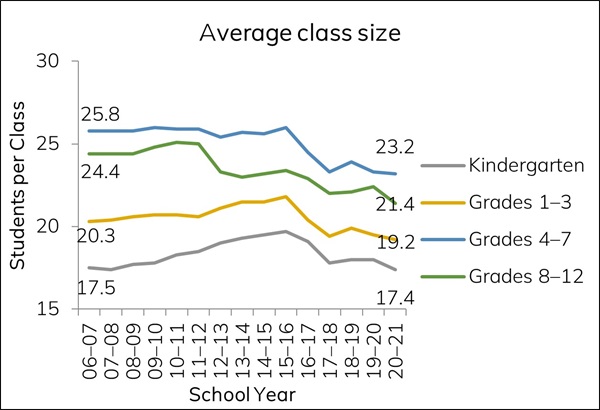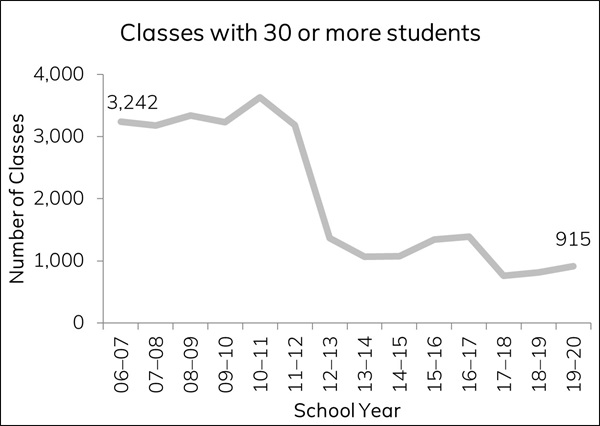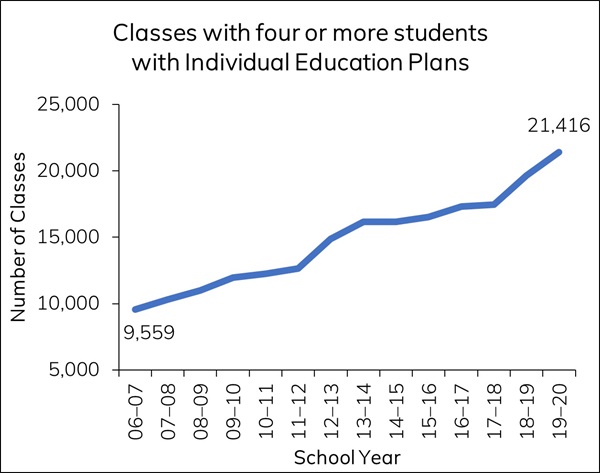Key Takeaways:
- The research on class size reduction is not definitive but a contested, ongoing debate.
- Student performance on standardized tests is not the only measure by which to examine the impacts of Class Size Reduction (CSR).
- The research on CSR has been severely limited by the singular focus on student academic performance, although some studies have sought to expand the conversation by focusing on the impact of CSR on teaching conditions, classroom environment, student learning experience.
- The research showing ‘class size isn’t important’ has been extensively critiqued for philosophical and methodological weaknesses.
- Reducing class size in and of itself is not a magic bullet. It’s more about what teachers and students can do when class sizes are lower, and a growing number of studies illustrate the way teaching and students’ learning experience can change with smaller class sizes.
- Class size is an important condition to teachers’ work that impacts recruitment and retention.
Class size has been a topic of intense debate among teachers, administrators, academics, and educational authorities (i.e., Ministry of Education) for decades. There is a relatively large body of research on class size, most of which has focused on determining whether class size reduction (CSR) has an impact on student academic achievement. There is also a smaller (but growing) body of research that looks at how CSR impacts teaching and learning in the classroom.
Because classrooms are complex social contexts, it is challenging to isolate and determine the influence of one variable, such as class size, on any aspect of school experience (Bouguen, Grenet, & Gurgand, 2017). Most research to date has looked at student achievement on standardized tests to make claims about the impact and merits of CSR (Bascia & Faubert, 2012; Blatchford, 2012; Blatchford, Russell & Brown, 2009; Laitsch, Nguyen, Ho Younghusband, 2021). Varying perspectives have emerged within this much-debated arena, but there is general agreement, widely accepted regardless of where one stands on the issue, that smaller classes have a positive impact on younger students’ academic performance, appearing most beneficial in the early years between Kindergarten to Grade 3 (Blatchford, Russell & Brown, 2009; Harfitt & Tsui, 2015; Laitsch, Nguyen, Ho Younghusband, 2021).
CSR research focusing solely on student performance misses the mark
A key hinge point in the discussion on CSR in relation to student academic achievement has been the cost of implementing small class sizes. However, the myopic focus on student achievement on standardized tests as the key mechanism for meaningful discussion on CSR is significantly limiting and does little to help scholars, practitioners and policy makers understand how class size may impact the teaching and learning experience holistically (Bascia & Faubert, 2012; Harfitt & Tsui, 2015).
For those looking at the issue through an economic lens of cost-benefit analysis, the cost does not justify the small potential gains that education systems may see in terms of student achievement (i.e., improved test scores). Further, if there is some benefit it is better to invest in CSR in the earlier grades only (Hanushek, 1998; Hattie, 2009).
However, other scholars have argued there’s more to the CSR conversation than simply economics.
The narrow focus on student test achievement ignores the dynamic and complex realities of classrooms and the entire teaching and learning experience. As Peter Blatchford, renowned scholar on class size research has written, “the class sizes debate is tired and asks the wrong questions” (Blatchford, 2015). It is vital to meaningfully consider other outcomes of education apart from test performance in the conversation around class size, what some scholars have referred to as ‘non-cognitive’ aspects of the educational experience (Finn, 2019).
The research showing ‘class size isn’t important’ has been extensively critiqued
In addition to focusing on the wrong questions, scholarship arguing against reducing class sizes has been critiqued for both philosophical and methodological weaknesses. Perhaps one of the most well-known opponents of class size reduction is Professor John Hattie (University of Auckland in New Zealand). In his 2009 book Visible Learning, Hattie carries out a synthesis of 800 meta-analysis on educational interventions with the aim of illuminating the key influences on student achievement. Providing each intervention an average effect size, Hattie argues that resources should be put towards interventions that work better, defined by having an effect size of 0.40 or higher. In his analysis, class size (with an effect size of 0.21) is not particularly strong, with Hattie suggesting a better use of scarce resources is to employ other interventions towards ‘improving teacher quality.’
Three reasons to question Hattie’s dismissal of smaller class size
Hattie’s work has been critiqued by numerous scholars, both for its statistical and methodological problems and its philosophical underpinnings. Three of these critiques are important to highlight.
Erroneous understanding of class size as a pedagogical intervention
Hattie inappropriately characterizes class size as a pedagogical intervention. As Blatchford, Russell & Brown (2009) point out, it’s not appropriate to treat class size as an educational intervention comparable to other methods or interventions, such as peer-to-peer tutoring, phonics training, etc. Rather, class size reduction is better understood and examined as a contextual factor (and not a specific method) that can facilitate the implementation of many pedagogical interventions and best practices.
Further, zeroing in on CSR and examining it compared to other educational interventions assumes these are somehow mutually exclusive. Class size reduction should not be seen as oppositional to or separate from other best pedagogical practices, but rather, as symbiotic, and mutually reinforcing (Bascia & Faubert, 2012; Bascia & Rottmann, 2011). In other words, CSR is an important classroom factor that can provide a more fruitful learning and teaching environment for more successful implementation of key pedagogical practices (Blatchford, Russell & Brown, 2009). In fact, it’s hard to imagine how many of the key teaching practices touted as being highly effective can be done without reasonable class sizes. A growing body of research demonstrates that many of the most promoted teaching and learning strategies are indeed better supported in smaller classes (Finn, 2019).
Ignoring broader social and contextual factors
In addition, Hattie’s work focuses solely on quantifiable measures when considering the value of reduced class size: student achievement outcomes. This aligns with a broader neoliberal technocratic approach to education, grounded in ableist assumptions. Understanding “what works” means “what’s visible, quantifiable and easily converted into data sets to measure educational outcomes.” The result is no consideration being given to local or broader social contexts of teaching and learning; factors we know have a large impact on what happens in classrooms (McKnight & Whitburn, 2018).
Unsound statistical analysis
Finally, numerous authors have critiqued the quality of Hattie’s statistical analysis. To start, Hattie’s task of distilling the most beneficial educational interventions by examining meta-analysis of widely different studies (that used different methods and sample sizes) is subject to numerous caveats surrounding the limitations of the data and its conclusions should be taken with caution. Hattie’s approach of averaging effect sizes from the effect sizes of various interventions included in the over 800 meta-analysis is problematic, while reducing everything to an effect size is extremely simplistic. Moreover, comparing various interventions on a ‘barometer of influence scale’ (as he does in his book) is arbitrary (Bergeron & Rivard, 2017). Further, there is little attention to and no adjustment for the quality of underlying studies of the various meta-analysis he synthesizes. Any meta-analysis is only as good as the underlying studies. While some of the studies Hattie considered may be of high quality, it is clear some are not. Without correcting for the effects of weak studies, it is difficult to know just how powerful Hattie’s results are, even taken on his own terms.
Hattie’s problematic and overly simplistic analysis has nevertheless been used to negate the impact of class size reduction on teaching and learning, ignore broader systemic factors (such as adequacy of funding and resources), and instead promote solutions that focus on improving teacher quality. This is not to say that teacher quality is not important. Rather, as Blatchford (2012) has noted, the argument of “class size doesn’t matter teacher quality does is too simplistic…both are clearly important” (p. 71).
Expanding research on class size: The benefits of CSR on teacher and student experience
Some CSR researchers have sought to advance the conversation on class size beyond the economic austerity focus of cost-benefit analysis and student test performance to better understand what teaching and learning actually look like in small classes and how students and teachers are impacted. For example, several studies have shown improved classroom management with smaller classes (Achilles, 1999; Finn, 2019). Further, teachers are able to individualize their teaching and differentiate instruction in smaller class sizes to better support students’ unique needs (Achilles, 1999; Bascia & Faubert, 2012; Blatchford, 2012; Finn, 2019; Korostoff, 1998). This not only affords students varied opportunities to learn, but it also helps support teachers’ sense of efficacy. As Bascia & Rottman note in their analysis of Ontario’s Primary Class Size Reduction initiative, “…primary teachers felt successful because they saw changes in their students’ opportunities to learn…” (pp. 797-798).
Research has also demonstrated greater student participation and academic engagement in smaller class sizes—a positive impact extending to secondary students as well (Blatchford et al, 2011; Finn, 2019; Harfitt & Tsui, 2015). There are also documented social and emotional benefits to smaller class sizes (Bascia & Faubert, 2012; Harfitt & Tsui, 2015). For example, smaller class sizes allow teachers more time to chat and get to know students—an integral component to relationship building (Achilles, 1999; Finn, 2019).
Class size as a condition of teachers’ working conditions and retention
While most CSR research looks at class size from the standpoint of impact on student achievement and teachers’ pedagogy, a smaller subset of the literature has emphasized class size as a central condition of teachers’ work. Bascia & Rottmann (2012) for example, have argued the need to understand “teaching conditions and students’ opportunities to learn in mutually reinforcing ways” (p. 796). Class size is an important element in teachers’ working conditions and indeed matters when it comes to the teaching and learning taking place in a classroom.
The positive impact on teacher self-efficacy mentioned above aligns with strong research showing how teacher morale increases with smaller class sizes (Finn, 2019). Increased teacher morale and the connection to job satisfaction are important factors in the context of an ongoing teacher recruitment and retention challenge here in BC.
Further, as Hirsch et. al (2007) emphasize, there is a direct connection between working conditions and teacher recruitment and retention. In their analysis of the 2006 Teacher Working Condition Survey in North Carolina, Hirsch and colleagues note that monetary incentives are much less effective at retention compared to improving working conditions. In other words, class size reduction (and other improvements to working conditions) are effective recruitment and retention strategies.
Class size in the BC context
Maintaining reasonable class sizes is an integral part of ensuring sustainable working conditions for teachers. The charts below show historical class size averages in BC. As of the 2020–21 school year, average class size for kindergarten is about 17 students (17.4). Grades 1–3 average about 19 students per class. Grades 4–7 are a bit higher at about 23 students per class (23.2) and high school classes average about 21 students (21.4).

Of note is the marked decline of classes with 30 or more students over the last decade, facilitated by consistent BCTF advocacy efforts including the 2016 Supreme Court of Canada ruling. As of the 2019–20 school year, there were a total of 915 classes in BC with 30 or more students.

BC teachers work in complex classroom environments alongside students with diverse social and learning needs. Over the past decade, the number of students with individual education plans (IEPs) has steadily increased, signalling a critical need for enhanced and varied supports. The complexity of today’s classroom environment underscores the importance of maintaining reasonable class sizes as one of several systemic measures to enable BC teachers to provide rich and equitable learning experiences for all students.

What the research says: Class size does matter (PDF)
References
Achilles, C. M. (1999). Let's put kids first, finally: Getting class size right. Corwin Press, Inc.
Bascia, N., & Faubert, B. (2012). Primary class size reduction: How policy space, physical space, and spatiality shape what happens in real schools. Leadership and Policy in Schools, 11(3), 344-364.
Bascia, N., & Rottmann, C. (2011). What’s so important about teachers’ working conditions? The fatal flaw in North American educational reform. Journal of Education Policy, 26(6), 787-802.
Bergeron, P. J., & Rivard, L. (2017). How to engage in pseudoscience with real data: A criticism of John Hattie’s arguments in Visible Learning from the perspective of a statistician. McGill Journal of Education/Revue des sciences de l'éducation de McGill, 52(1), 237-246.
Blatchford, P. (2012). Class size: is small better. Bad education: Debunking myths in education, 57-76.
Blatchford, P. (2015). The class size debate is tired and asks the wrong questions. The Guardian. [online], available at: www.theguardian.com/commentisfree/2015/feb/13/class-size-debate-asks-wrong-question-simplistic
Blatchford, P., Russell, A., & Brown, P. (2009). Teaching in large and small classes. In International handbook of research on teachers and teaching (pp. 779-790). Springer.
Bouguen, A., Grenet, J., & Gurgand, M. (2017). Does class size influence student achievement? Retrieved from www.shs.hal.science/halshs-02522747/document
Finn, J. D. (2019). Academic and non-cognitive effects of small classes. International Journal of Educational Research, 96, 125-135.
Hanushek, E. A. (1998). The Evidence on Class Size. Occasional Paper. [online], available at: www.files.eric.ed.gov/fulltext/ED443158.pdf.
Harfitt, G. J., & Tsui, A. B. (2015). An examination of class size reduction on teaching and learning processes: A theoretical perspective. British Educational Research Journal, 41(5), 845-865.
Hattie, J. (2009). Visible learning: A synthesis of over 800 meta-analyses relating to achievement. Routledge.
Hirsch, E., & Emerick, S. (2007). Teacher Working Conditions Are Student Learning Conditions: A Report on the 2006 North Carolina Teacher Working Conditions Survey. Center for Teaching Quality.
Korostoff, M. (1998). Tackling California’s class size reduction policy initiative: An up close and personal account of how teachers and learners responded. International Journal of Educational Research, 29(8), 797-807.
Laitsch, D., Nguyen, H., & Younghusband, C. H. (2021). Class size and teacher work: Research provided to the BCTF in their struggle to negotiate teacher working conditions. Canadian Journal of Educational Administration and Policy/Revue canadienne en administration et politique de l’éducation, (196), 83-101.
McKnight, L., & Whitburn, B. (2020). Seven reasons to question the hegemony of Visible Learning. Discourse: Studies in the cultural politics of education, 41(1), 32- 44.